![]()
![]()
![]()
Use LEFT and RIGHT arrow keys to navigate between flashcards;
Use UP and DOWN arrow keys to flip the card;
H to show hint;
A reads text to speech;
17 Cards in this Set
- Front
- Back
|
Choosing Semen, IMPORTANT for decision...
|
(1) Interpreting information in catalogues
(2) Comparing economic benefit of sires |
|
|
Predicted Transmitting Ability (PTA)
|
Predicted Transmitting Ability (PTA) is the average genetic value for a certain trait that an animal transmits to its offspring.
It is 1/2 the Estimated Breeding Value (EBV) b/c offspring only inherit one half of their genes from each parent. --> Dairy farmers, & semen catalogues = use PTA (instead of EBV) |
|
|
Semen Catalogue
|
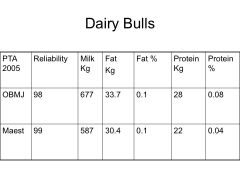
Information included in semen catalogue;
(1) PTA for milk (kg) (2) PTA for fat (kg) (3) PTA for fat % (4) PTA for protein (kg) (5) PTA for protein % --> PTA's are calculated for a given bull every 5 years (Year on table = year PTA calculated) |
|
|
Interpreting Semen Catalogue Information
|
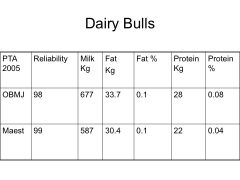
- Daughters of OBMJ going to produce 677 kg MORE milk than the average, per lactation.
- Daughters of OBMJ going to produce 3.3 kg MORE fat per lactation than Maestro's daughters. - Maestro's daughters going to produce 4% less protein per lactation than OBMJ's daughters, but 4% more protein per lactation than average. |
|
|
Reliability
|
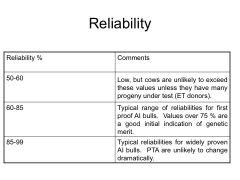
Reliabilities indicate the chance that the PTA will change in future as new information becomes available. (Reliability is one of the first things looked at on semen catalogue, because no matter how good the statistics, values don't mean much if low Reliability.)
--> Initial proofing bulls tend to have lower reliability numbers. Low reliability bulls tend to be less expensive, can be a gamble; may turn out to be a great or not-so-great-bull. |
|
|
Norwegian Cattle Breeding System (Pertaining to Reliability)
|
Norway; If apart of this scheme, 1/2 of cows have to be bred to certain top bulls, and 1/2 are bred to a less reliable, unproven bull.
While there is less choice for the farmer, it is a more efficient system (new bulls are tested to see what their potential is) |
|
|
Low vs. High Reliability Bull
|
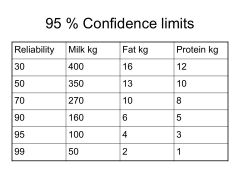
LOW RELIABILITY; Can turn out to be a superb bull, or not as good as 1st appeared. (Predicted Transmitting Ability (PTA) values may be higher than bull's w/ higher reliability, but not as likely those are the results you achieve...)
HIGH RELIABILITY: Widely used bulls w/ high reliability; expect consistent results, & don't expect a lot of variation from PTA values listed. |
|
|
Indices
|
Many top bulls have been tested in other countries, and results have been converted to different indices, using established guidelines;
(1) PIN: Profit Index = the predicted additional margin/profit per lactation, which the bull is expected to pass to its offspring --> PIN = a bull selection aid for farmers but also to put in monetary terms the benefit of using a particular bull. (2) ITEM: Index of total economic merit = (PIN + Type Traits); A refinement of PIN which takes into account the longevity of a particular sire’s progeny. Longevity is correlated with foot angle, teat length, angularity and udder depth. These are all given a different weighting in the formula. (3) PLI: Profitable Lifetime Index = (PIN + Fitness); How much money offspring are expected to earn in a lifetime compared to average cow. Weighting of production traits accounts for 45%, and health/welfare/fitness traits account for 55%. --> Indices reduce all the information (milk fat, udder, somatic cell count, lifespan, etc) to one meaningful value. |
|
|
Profitable Lifetime Index (PLI)
|
Relative Importance of traits in PLI;
FITNESS TRAITS (55%), which include; Lifespan (21.1%) > Fertility (18.5%) > Udder (5.6%) > SCC (5.5%) > Locomotion (4.1%) PRODUCTION TRAITS (45%) which include; Protein (21.8%) > Fat (12.4%) > Milk (10.9%) --> Milk protein = high ranking because of importance of protein in profit farmer gets for milk. |
|
|
Using LIFESPAN in index; impacts on Reliability
|
When lifespan/longevity is used in index; it leads to LOWER RELIABILITY, b/c not all daughters are culled yet. (Can't use lifespan data on a cow until she is culled)
|
|
|
Type Traits
|
Traits scored 1 - 9, unique to each breed society.
Traits measured = Mammary Traits (Udder Conformation? Long dangling udder? Long teats?), Hoof angle, Stature, Chest width, Body depth, Rump angle, Rump Width The genetic merit for type traits = are expressed as genetic indices & published as standardized breeding values, ranging from -3 to +3 standard deviations. (Mean = 0, +1 = 1 standard deviation above mean for example.) Type traits when plotted follow a normal distribution (99.9% lie w/in 3 standard deviations from mean...unusual to get beyond that) |
|
|
Genetic Merit for Type Traits; Type Merit (TM) & Cow Type Index (CTI)
|
The genetic merit for type traits are expressed in genetic indices;
- Type merit (TM) for bulls - Cow type index (CTI) for cows They are expressed as standard deviations, and most (99.9%) animals fall w/in range of -3 to +3 standard deviations from mean. EXAMPLE; Type Merit, how traits are proportionally weighted... (1) 40% mammary, (2) 30% legs and feet, (3) 30% combination of lifespan predictors (stature, angularity, body depth, chest width, rump angle, rump width) |
|
|
Longevity; Linear Type Traits
|
Longevity/Lifespan is predicted with a combination of linear type traits.
Can be useful when looking at susceptibility to disease. Beneficial traits for example; (a) steeper foot angle, (b) shallower udder depth, (c) shorter teat length. |
|
|
(Value to Farmer of Semen from Different Bulls) # Straws for Replacement Heifer Calculation
|
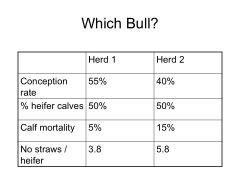
Two Herds, Calculating # straws semen for each replacement heifer calf:
(1) HERD 1: (a) 55% Conception rate, so (100 / 55) = 1.8 --> 1.8 straws of semen to produce a calf. (b) Only 50% calves are female, so (1.8 x 2) = 3.6 straws needed to produce female calf (c) 5% Calf mortality (need to offset calf mortality), so 3.6 straws semen x 1.05 = 3.8 straws semen for each heifer calf. (2) HERD 2: (a) 100/40 = 2.5 straws for each replacement calf (b) 2.5 x 2 = 5 straws for replacement heifer (c) 15% calf mortality; 5 x 1.15 = 5.8 straws for each replacement heifer. |
|
|
(Value to Farmer of Semen from Different Bulls) Factoring in ITEM values & Costs per straw semen
|

Bull A = producing more profitable offspring (higher PLI value) --> More in demand, so semen more expensive.
(a) Calculate cost for replacement heifer. (If already calculated # straws semen necessary for replacement heifer in a specific herd, multiply by cost per straw) (b) Calculate Profit per heifer calf. (Profit per heifer calf; assume 4 lactations.) -->(Multiply Bulls PLI x 4) and subtract cost of semen per heifer calf. Compare b/w two bulls, which produced a higher profit per heifer in the specific herd. Depending on the situation, it may be more profitable to use one bull over another. |
|
|
Steps in Bull Selection
|
(1) Rank bulls on PTA or PLI. (Take into account how will impact profitability.)
(2) Consider the reliability of the proofs. (Some may not want to risk low reliable bulls, bringing in poor genes into gene pool.) (3) Eliminate undesirable type, pedigree carriers. (No need to breed disease in. Avoid inbreeding, eliminate bulls with undesirable type, and deleterious genes.) (4) Eliminate bulls outwith price range. (If can't afford, eliminate.) |
|
|
Breeding & Bulls of Superior Genetic Merit
|
In general, it pays to use bulls of superior genetic merit. It has a cumulative effect. The genes will persist for a long time (making it often times worth while paying extra).
|

